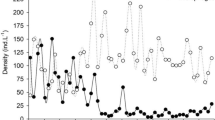Abstract
Spatial and temporal fluctuations in rotifer abundance have been monitored along a trophic gradient in the northern Baltic. The most common rotifer was Synchaeta spp., which had one abundance peak in June and one in September–October. Only during the latter period was the abundance significantly higher in the eutrophic basin compared to the reference area. The annual production of Synchaeta spp. was about double in the eutrophic basin. A positive correlation between Synchaeta spp. biomass and phytoplankton biomass was obtained during the autumn, but not during the early summer peak, although the phytoplankton community was dominated by the same species. Keratella quadrata, K. cochlearis and K. cruciformis were most abundant in August–September, and all three species had increased abundance in the eutrophic basin.
Similar content being viewed by others
References
Ackefors, H., 1972. The amount of zooplankton expressed as numbers, wet weight and carbon content in the Askö area. Medd. Havsfiskelab., Lysekil, 129 pp. (mimeogr.).
Dumont, H., 1977. Biotic factors in the population dynamics of rotifers. Arch. Hydrobiol. Beih. 8: 98–122.
Dybern, B. L, Ackefors, H. & Elmgren, R., 1976. Recommendation on methods for marine biological studies in the Baltic Sea. Baltic mar. Biol. 1, 98 pp.
Fuller, D. R., Stemberger, R. S. & Gannon, J. E., 1977. Limnetic rotifers as indicators of trophic change. J. Elisha Mitchell Sci. Soc. 93: 104–113.
Gannon, J. E. & Stemberger, R. S., 1978. Zooplankton (especially crustaceans and rotifers) as indicators of water quality. Trans. am. microsc. Soc. 97: 16–35.
Gliwicz, Z. M., 1969. The share of algae, bacteria and trypton in the food of the pelagic zooplankton of lakes with various trophic characteristics. Bull. Acad. Sci. 3: 159–165.
Gliwicz, Z. M. & Hillbricht-Ilkowska, A., 1972. Efficiency of the ultization of nannoplankton primary production by communities of filter feeding animals measured in situ. Verh. int. Ver. Limnol. 18: 197–203.
Hernroth, L. & Viljamaa, H., 1979. Recommendations on methods for marine biological studies in the Baltic Sea. Mesozooplankton biomass assessment. Baltic mar. Biol. 6, 15 pp.
Hillbricht-Ilkowska, A., Spodniewska, I. & Weglénska, T., 1979. Changes in the phytoplankton-zooplankton relationship connected with the eutrophication of lakes. Symp. Biol. Hung. 19: 59–75.
Hobro, R., 1979. Annual phytoplankton succession in a coastal area in the northern Baltic. In Naylor, E. & Hartnoll, R. G. (Eds.), Cyclic phenomena in marine plants and animals. Pergamon Press, Oxford, N.Y. pp. 3–10.
Hofmann, W., 1977. The influence of abiotic environmental factors on population dynamics in planktonic rotifers. Arch. Hydrobiol. Beih. 8: 77–83.
Kankaala, P. & Wulff, F., 1981. Experimental studies on temperature dependent embryonic and postembryonic developmental rates of Bosmina longispina maritima (Cladocera) in the Baltic. Oikos 36: 137–146.
Kott, P., 1953. Modified whirling apparatus for the subsampling of plankton. Austr. J. mar. freshwat. Res. 4: 387–393.
Larsson, U. & Hagstrom, Å., 1982. Fractionated phytoplankton primary production, exudate release and bacterial production in a Baltic eutrophication gradient. Mar. Biol. 67: 57–70.
Lehmann, E. L., 1975. Nonparametrics, statistical methods based on ranks. Holden-Day, Inc., San Francisco, McGrawHill Internat. Book Co., New York. 457 pp.
Melvasalo, T. & Viljamaa, H., 1975. Plankton composition in the Helsinki area. Merentutkimuslait Julk./ Havsforskningsinst. 239: 301–310.
Mullin, M. M. 1969. Production of zooplankton in the ocean: the present status and problems. Oceanogr. mar. Biol. Rev. 7: 293–314.
Naumann, E., 1923. Specielle Untersuchungen fiber die Ernäh-rungsbiologie and die natüurliche Nahrung der Copopoden and der Rotiferan des Limnoplanktons. Lunds Univ. Arsskrift N.F. 2, 19: 1–17.
Nauwerck, A., 1963. Die Beziehungen zwischen Zooplankton and Phytoplankton im See Erken. Symb. bot. Ups. 17: 1–163.
Pourriot, R., 1977. Food and feeding habits of Rotifera. Arch. Hydrobiol. Beih. 8: 243–260.
Radwan, S., 1980. The effect of some biotic and abiotic factors on the fertility of planktonic rotifers species. Hydrobiologia 73: 59–62.
Sokal, R. R. & Rohlf, F. J., 1981. Biometry. The principles and practice of statistics in biological research. 2nd ed., W. H. Freeman & Co., San Francisco. 859 pp.
Stemberger, R. S., 1981. A general approach to the culture of planktonic rotifers. Can. J. Fish. aquat. Sci. 38: 721–724.
Stemberger, R. S. & Gannon, J. E., 1977. Multivariate analysis of rotifer distributions in lake Huron. Arch. Hydrobiol. Beih. 8: 38–42.
UNESCO, 1968. Zooplankton sampling. Monogr. oceanogr. Methodology. 174 pp.
Utermöhl, H., 1958. Zur Vervollkommung der quantitativen Phytoplankton Methodik. Mitt. int. Ber. Limnol. 9: 1–38.
Winberg, G. G., 1971. Methods for the estimation of production of aquatic animals. Academic Press, London, New York. 175 pp.
Author information
Authors and Affiliations
Rights and permissions
About this article
Cite this article
Johansson, S. Annual dynamics and production of rotifers in an eutrophication gradient in the Baltic Sea. Hydrobiologia 104, 335–340 (1983). https://doi.org/10.1007/BF00045987
Issue Date:
DOI: https://doi.org/10.1007/BF00045987




